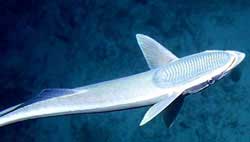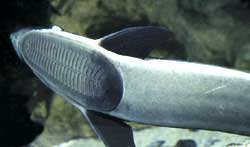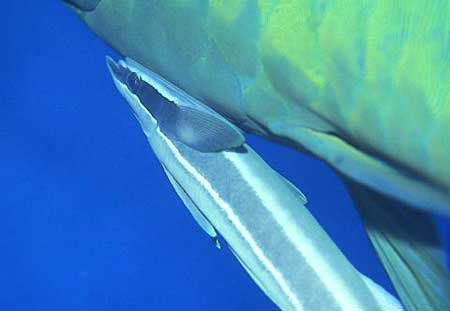 The remora, scientifically known as Echeneis naucrates, is commonly found in warm waters of the Atlantic Ocean, Pacific Ocean, and Indian Ocean. When not attached to a host, they prefer to swim freely in coastal areas, slightly brackish waters, or around coral reefs.
The remora, scientifically known as Echeneis naucrates, is commonly found in warm waters of the Atlantic Ocean, Pacific Ocean, and Indian Ocean. When not attached to a host, they prefer to swim freely in coastal areas, slightly brackish waters, or around coral reefs.
This species is easily identifiable due to its disc-shaped sucking organ located on its flattened head. This sucking disc can create a strong vacuum force, allowing it to cling tightly to a host. Once a remora has attached itself to something, it is difficult to detach. These fish can grow to nearly 1 meter in length, with a slender body and a black stripe on each flank.
At a glance, it is quite challenging to differentiate between males and females. After fertilization, the eggs are encased in a hard shell that protects them from damage and drying out. The spherical eggs float just below the water’s surface. Interestingly, the eggs can hatch normally even when washed ashore by waves.
Newly hatched remoras are about 4.7-7.5 mm long. They live freely for about a year until they reach approximately 3 cm in length, at which point they can attach to a host. However, it takes 3-5 years for a remora to reach full maturity.
Remoras typically attach themselves to aquatic animals such as sharks, yellowfin tuna, dolphins, turtles, and whales. It is common to find several remoras clinging to the same host.
 In this commensal relationship, the host is not harmed, while the remora benefits significantly. The remora feeds on leftovers from the host (including morsels that the host drops or discards). Additionally, remoras also eat various crustaceans that cling to the host’s skin. When convenient, they supplement their diet with small free-living creatures such as crustaceans, fish, and squid.
In this commensal relationship, the host is not harmed, while the remora benefits significantly. The remora feeds on leftovers from the host (including morsels that the host drops or discards). Additionally, remoras also eat various crustaceans that cling to the host’s skin. When convenient, they supplement their diet with small free-living creatures such as crustaceans, fish, and squid.
By attaching to a host, remoras conserve energy, using the host as a means of transportation. Since they are poor swimmers and lack a swim bladder, they frequently take on the role of “hitchhiker.” When attached to a host, they also use it as a shield against predatory fish.
Remoras do occasionally swim freely, especially when they have not yet found a suitable host.
In the past, these fish were used as “live bait” to catch various seafood. Fishermen would tie a line to a remora and drop it into deep water. Since remoras instinctively seek to attach to a host, they would quickly find something suitable upon entering the water, allowing fishermen to pull the remora and its host back to shore.
However, remoras can also be a nuisance; they can use their powerful suction disc to cling to the hulls of boats, potentially causing damage and even sinking vessels if they create enough large holes. They can also attach to swimmers, causing discomfort. Ancient Greeks held a disdain for these fish, believing that remoras possessed mysterious powers that could slow down or even halt their boats.
When placed in fish farming ponds, remoras typically stay near the bottom of the water. However, when food is present, they will boldly swim to the surface to eat pieces of clams or fish offered by hand.


















































